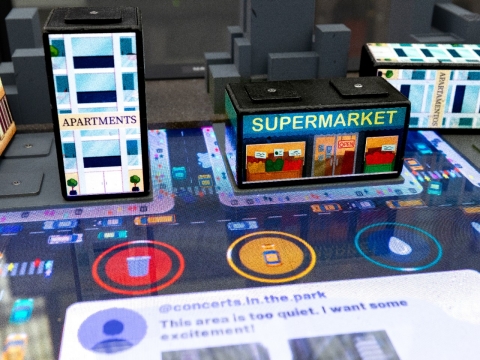plight of a city bus driver by operating the steering wheel of a blue municipal “bus” and staring into a “windshield” that streams a vendor’s cart butting into traffic, a double-parked delivery truck, and jaywalkers.
Other exhibit sections let visitors haul a bulging bag of trash like a city sanitation worker; grapple with the materials, engineering, and processes that go into building a skyscraper; and learn about transportation, water, and waste-water systems; as well as the New Yorkers who make them go.
Bonczak helped build a part of the exhibit broadly associated with city planning and decision making, as it highlights the interdependence of city infrastructure with models of three neighborhoods that can be assembled on interactive tables with toy building blocks containing digital sensors. Science students can choose to play with representations of Midtown Manhattan, industrial Brooklyn, and residential Queens. The models simulate the effects of new development and climate change, using data on actual population density, traffic, waste accumulation, and flood risks.
Scheduled to remain on display for 10 years, “CityWorks” began taking shape when practitioners and planners, Bonczak among them, began meeting around a table on a regular basis with a wide cast of specialists, practitioners, and museum directors. Their individual areas of expertise spanned journalism, psychology, environmental protection, engineering, city government management, and other fields and disciplines. Also tapped by the museum for data and perspective were NYU’s professor of anthropology and environmental studies Robin Nagel, professor of civil and urban engineering and CUSP faculty member Deborah Laefer, and adjunct faculty member John Surico of the Arthur L. Carter Journalism Institute.
When the blueprint for the exhibition emerged this year, Bonczak and the other volunteers spread? out to work on discrete sections of the infrastructure exhibition that became what The New York Times wrote “unabashedly celebrates cities by exploring how they were developed and built, and has fun getting hands-on with the complex technology and often messy infrastructure required to provide water, sanitation and transportation to millions of residents.”
“With people like Bartosz, the obvious benefit of consulting with them was the nuts-and-bolts of their expertise, said Katie McMillan Culp, chief learning officer at the New York Hall of Science. “They know so many uncovered secrets that are fascinating to the rest of us, and became part of the exhibition.”
“But even more importantly,” she added, “they helped us understand how they think about, and solve, problems in their work. Discovering how they organized their thinking gave us a template, and the pathways to understanding, that we want our visitors to experience.
For Bonczak, working on the project was also a “learning experience.” He’s a PhD candidate in the program in urban systems at NYU Tandon School of Engineering,
“It was eye opening to see how much, and how many, forms of expertise you need in order to convey complexities in a very digestible and accessible way,” particularly when demonstrating the interconnected systems of a major urban area, he explained.

